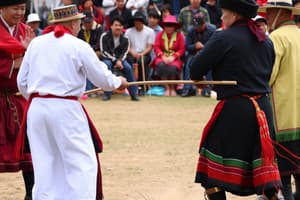Podcast
Questions and Answers
Дайны сургуульд суралцахад дасгалжиний дундаж хэсэг буюу бага нар нь яаж гарахад зөв шийдэхийг сонсож байна?
Дайны сургуульд суралцахад дасгалжиний дундаж хэсэг буюу бага нар нь яаж гарахад зөв шийдэхийг сонсож байна?
Тэмцэх урлаг = Ялалт Хөгжлийн тоглоом = Боловсролын тусламж Англи хэл = Санаачилсан шүтлэг Түүх = Тогтолцоо
Үейн тохируулагчид ямар ч хөдөлмөрийн хамтран ажиллахыг анзаарч байна?
Үейн тохируулагчид ямар ч хөдөлмөрийн хамтран ажиллахыг анзаарч байна?
Монгол шашин = Тослог Буддизм = Мэргэжлийн талбайд Демократи = Улсын засаглал Христийн шашин = Боловсрол
Шашны хамт оргож байгалийн арга хэмжээний талаар ямар мэдээллийг нь олно вэ?
Шашны хамт оргож байгалийн арга хэмжээний талаар ямар мэдээллийг нь олно вэ?
Хүний өмч = Өвчний эрүүл мэдээллийн чанар Морьтой үзүүлэлт = Гадаадад
Төрийн үеийн тархалтын талаар яаж суралцаж байна?
Төрийн үеийн тархалтын талаар яаж суралцаж байна?
бууз (хаврын юмаар уяачих) гурван сургуулиасыг дагаж яаж дурдан тодорхоод байна?
бууз (хаврын юмаар уяачих) гурван сургуулиасыг дагаж яаж дурдан тодорхоод байна?
Study Notes
Overview of Mongolian Culture
In this comprehensive guide, we will explore different aspects of Mongolian culture, including its values, traditions, history, and practices. We begin by uncovering some fundamental principles that shape the lives of people living within a country that boasts one of the most ancient cultures in the world.
Values in Mongolian Society
The core of Mongolian life is based on several strong cultural ideals. One essential value is nemeh, which can be translated from the Mongolian word as honor or reputation. Maintaining a good nemeh means being well-respected among community members. This concept emphasizes personal responsibility, respect for others' beliefs, and maintaining dignity without resorting to violence or aggression.
Another key trait is khaat, meaning hospitality and generosity. In traditional Mongolian society, sharing food with visitors was highly valued. Visitors were treated like guests of honor and shared meals together. However, these practices have been somewhat affected due to modernization.
Finally, there is the importance placed on kindness (kharam), understanding between individuals, and a peaceful resolution of conflicts. These traits contribute significantly to the preservation of harmony within the family unit and larger communities.
Childhood in Mongolia
Children play a vital role in Mongolian families, where they may be highly involved in their parents' work. They often accompany them when herding livestock or assist with household chores such as cooking or fetching water. Education plays a significant part in shaping children into responsible adults who understand the importance of cooperation and selflessness.
Traditional games serve as learning tools while also providing entertainment. For instance, buuz (steamed buns filled with meat) may represent happiness during festivals. Children learn songs and dances associated with celebrations, brushing up on important social skills.
School attendance has become more common lately since the government began offering free education. But rural areas still lack schools, so many children do not attend formal schooling. Instead, they learn practical knowledge like riding horses, herding animals, and working with wool from young ages.
Cultural Norms in Mongolia
Regarding religious practices, Buddhist monasteries remain central institutions across much of Mongolia. However, other faiths like Islam, Christianity, and Shamanism coexist peacefully among various ethnic groups. Traditions around death and mourning involve offerings made to the deceased before burial and visits paid after burials. Funerary rituals reflect deep spiritual connections among tribes identified by totems. After someone passes away, certain items belonging to him/her might be buried along with the body.
Aspects of dress vary depending upon location - nomads in western regions wear traditional garments called deels, while urban populations favor Western attire. Gender roles traditionally defined men as hunters and protectors while women focus on home activities; however, both genders share responsibilities today.
History
A brief overview of recent history:
19th century saw Russia and China vying for control over territories inhabited by nomadic peoples through military force & diplomacy.
From 1860 to 1911, Outer Mongolia had Chinese rule.
After WWI, Mongols declared independence from Qing Dynasty & formed alliance with Soviet Union against China.
With Japanese invasion, Russia intervened militarily until 1939. During World War II, Mongolia contributed troops to fight alongside Russian forces.
During Stalinist purges under Khrushchev, thousands of innocent Mongolians died.
Peaceful transition took place in 1990 with Mongolia declaring multi-party democracy.
Studying That Suits You
Use AI to generate personalized quizzes and flashcards to suit your learning preferences.
Description
Test your knowledge on Mongolian culture with this quiz covering values, traditions, childhood, cultural norms, and a brief history overview. Explore the core values of nemeh and khaat, learn about childhood upbringing in Mongolia, understand cultural norms related to religion and dress, and grasp key historical events that have shaped the country.



